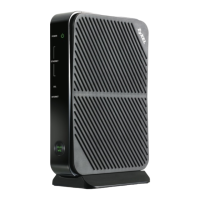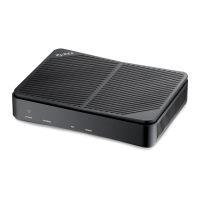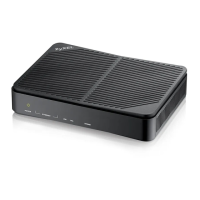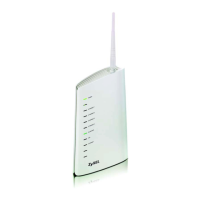
Do you have a question about the ZyXEL Communications P-660HN-51 and is the answer not in the manual?
| Brand | ZyXEL Communications |
|---|---|
| Model | P-660HN-51 |
| Category | Gateway |
| Language | English |
Provides a general overview of the Zyxel P-660HN-51 ADSL2+ router, its features, and product name format.
Details the methods available for managing the Zyxel Device, including Web Configurator, CLI, FTP, and TR-069.
Offers advice on maintaining security and effective management of the Zyxel Device, such as changing passwords.
Introduces the web configurator as an HTML-based management interface for device setup and management.
Describes the layout of the web configurator, dividing it into the title bar, main window, and navigation panel.
Details the menu items and their corresponding functions within the navigation panel of the web configurator.
Explains that the Network Map shows connection status and the Status screen shows device, system, and interface information.
Describes how to view the network connection status of the device and its clients, with options for icon or list view.
Details how to view the status of the Zyxel Device, including device information, WAN, LAN, and interface status.
Introduces the chapter, which demonstrates how to use the Zyxel Device's various features through tutorials.
Provides a step-by-step guide on configuring an Internet connection using the Web Configurator and PPPoE.
Guides users through setting up a secure wireless network using WPS or manual configuration.
Explains how to create different wireless network groups (SSIDs) for various user types within a company.
Details how to configure a static routing rule to control traffic flow directions and connect to other networks.
Explains how to use Dynamic DNS (DDNS) to access the Zyxel Device via a domain name with a dynamic IP address.
Describes how to configure WAN settings using the Broadband screen for Internet access.
Explains essential concepts like Encapsulation Method and WAN IP Address required for Internet connection setup.
Guides users on changing Internet access settings and viewing configured WAN services on the Broadband screen.
Introduces the chapter that covers setting up the Zyxel Device's wireless connection using the Wireless screens.
Lists the tasks that can be performed in the Wireless section, such as enabling LAN, setting SSID, and configuring security.
Details how to enable Wireless LAN, enter SSID, and select the wireless security mode.
Explains how to enable and configure multiple Basic Service Sets (BSSs) on the Zyxel Device.
Describes how to configure MAC filtering to grant exclusive access or exclude specific devices from accessing the Zyxel Device.
Guides users on configuring WiFi Protected Setup (WPS) for quick and secure wireless network setup.
Explains how to enable Wi-Fi MultiMedia (WMM) and WMM Power Save for multimedia applications.
Details how to set up Wireless Distribution System (WDS) links to connect to other APs wirelessly.
Provides options for configuring advanced wireless settings like RTS/CTS Threshold and Fragmentation Threshold.
Provides in-depth technical information on wireless LANs, including network overview and security concepts.
Introduces Local Area Network (LAN) and its configuration for DHCP server and IP address management.
Outlines the capabilities of the LAN screens, including LAN Setup, Static DHCP, and UPnP configuration.
Explains how to set the Local Area Network IP address, subnet mask, and DHCP settings for the Zyxel Device.
Describes how to assign IP addresses to specific computers on the LAN based on their MAC addresses.
Details the Universal Plug and Play (UPnP) feature for simple peer-to-peer network connectivity.
Provides instructions for installing UPnP in Windows Me and Windows XP operating systems.
Introduces Network Address Translation (NAT) and its role in translating IP addresses for secure network communications.
Lists the NAT-related features that can be configured, including Port Forwarding, Applications, and DMZ.
Explains how to forward incoming service requests to servers on the local network, making them visible to the outside world.
Allows users to create new NAT application rules and manage existing ones for forwarding service requests.
Details how to configure port triggering to allow computers on the LAN to dynamically use services.
Explains how to configure a default server (DMZ host) that receives packets not specified in NAT Port Forwarding.
Describes how to enable and disable the SIP (VoIP) ALG for improved SIP call functionality through NAT.
Allows limiting the number of concurrent NAT sessions that all clients can use to manage network resources.
Provides more detailed information regarding NAT, including definitions of key terms and how NAT works.
Introduces MAC filtering for controlling access to specific devices or excluding devices from accessing the Zyxel Device.
Guides users on changing MAC filter settings and adding new MAC filter rules for wireless security.
Explains how to enable and configure the Zyxel Device firewall to protect the device and network from hacker attacks.
Lists the firewall features that can be configured, including security level, protocols, and access control.
Details how to set the firewall security level and configure rules based on packet travel direction.
Explains how to configure customized services and port numbers, and add/remove predefined Internet services.
Allows viewing and configuring incoming/outgoing filtering rules for the firewall.
Provides information on the Remote MGMT screen and Service Control for managing the Zyxel Device remotely.
Explains how to configure which interface(s) users can use to manage the Zyxel Device's services.
Introduces certificates for user authentication based on public-private key pairs.
Outlines tasks related to certificates, including generating requests and importing trusted CA certificates.
Defines key terms and concepts related to certificates and Certification Authorities (CAs).
Provides a summary list of certificates and certification requests, allowing generation and import.
Displays a list of trusted Certification Authorities (CAs) that the Zyxel Device accepts for certificate validation.
Introduces IPSec as a VPN solution for secure data communications across public networks.
Lists tasks related to IPSec, including viewing/editing policies and managing active VPN connections.
Explains the main fields for configuring IPSec VPN policies, including Auto(IKE) and Manual key setups.
Allows displaying and managing active VPN connections, showing the status of Security Associations (SAs).
Provides technical background information on IPSec architecture, encryption, and key management.
Explains parental control for permitting or blocking specific websites for home network computers.
Guides users on configuring parental control settings to block access to certain websites.
Introduces static routes for sending data to devices not reachable through the default gateway.
Explains how to view and configure static route rules on the Zyxel Device.
Explains DNS for mapping domain names to IP addresses and Dynamic DNS for updating IP addresses.
Guides users on viewing and configuring DNS routes on the Zyxel Device.
Details how to change DDNS settings, enabling Dynamic DNS and configuring service provider details.
Defines Quality of Service (QoS) and its role in delivering data with minimum delay and controlling bandwidth.
Lists QoS features that can be configured, including General settings, Queue Setup, Class Setup, and Monitor.
Explains key QoS concepts like QoS vs CoS, Tagging and Marking, and Traffic Shaping.
Details how to enable/disable QoS and set the upstream bandwidth for network performance optimization.
Guides users on configuring QoS queue assignment, including adding and managing queues.
Explains how to add, edit, or delete QoS classifiers to group traffic based on specific criteria.
Describes how to configure QoS policers to limit the transmission rate of incoming traffic.
Allows viewing the Zyxel Device's QoS packet statistics for monitoring network traffic performance.
Provides additional technical information related to QoS features and standards like IEEE 802.1Q Tag.
Explains the TR-069 protocol for auto-configuration settings of Customer Premise Equipment (CPE).
Guides users on configuring the Zyxel Device to be managed by an Auto Configuration Server (ACS).
Introduces system-related settings including system time, password, name, and inactivity timeout.
Explains how to configure the Zyxel Device's time and date based on the local time zone.
Describes how to define time periods and days for scheduled rules of features like Firewall Access Control.
Guides users on viewing, adding, or editing time schedule rules for specific features or users.
Introduces policy forwarding for overriding default routing behavior and altering packet forwarding based on policy.
Explains how to view and configure routing policies on the Zyxel Device.
Explains how to choose log categories and display logs or send them to an administrator.
Outlines tasks for viewing System Logs and Security Logs for selected event categories.
Guides users on viewing system logs for selected categories and managing log display options.
Explains how to view security-related logs for selected categories and differentiate alerts from logs.
Introduces Address Resolution Protocol (ARP) for mapping IP addresses to MAC addresses on a local network.
Explains the process of ARP requests and how the ARP table maintains associations between MAC and IP addresses.
Guides users on viewing IP-to-MAC address mappings in the ARP table.
Introduces Traffic Status screens for viewing network traffic and statistics of WAN and LAN interfaces.
Outlines tasks for viewing WAN traffic statistics and LAN traffic statistics.
Explains how to view the number of bytes received and sent on the Zyxel Device's WAN interface.
Describes how to view the interface that is currently connected on the Zyxel Device's LAN.
Introduces the Users Configuration screen for viewing, adding, and configuring user accounts.
Details the user configuration options, including retry times, idle timeout, and account types.
Explains how to configure where the Zyxel Device sends logs and which logs/alerts it records.
Guides users on changing the Zyxel Device's log settings for system and security logs.
Explains how to upload new firmware to the Zyxel Device to upgrade its performance.
Details the process of uploading firmware using HTTP, including necessary precautions and reboot procedures.
Introduces the Configuration screen for backing up, restoring, or resetting device settings to factory defaults.
Explains how to back up and restore device configurations, and reset settings to factory defaults.
Details how to remotely reboot the Zyxel Device without turning off the power, for example, if it hangs.
Introduces diagnostic methods for testing connections and viewing detailed information to identify problems.
Outlines tasks for identifying problems using Ping, TraceRoute, NsLookup, and OAM Ping Test.
Explains how to use Ping, TraceRoute, or Nslookup to test connections and identify network problems.
Details how to perform an ATM OAM loopback test to verify virtual circuit connectivity.
Provides guidance on resolving issues related to device power, hardware connections, and LED behavior.
Offers solutions for forgotten IP addresses or passwords and issues accessing the web configurator.
Provides steps to troubleshoot problems with Internet access or connection availability.
Addresses factors causing intermittent or unstable wireless connections and optimization methods.
Summarizes the hardware features of the Zyxel Device, including dimensions, weight, and ports.
Details the firmware specifications, including default IP address, subnet mask, and wireless functionality.
Lists the wireless features supported by the Zyxel Device, such as WPA2, WMM QoS, and WDS support.
Provides instructions for configuring TCP/IP settings on Windows 95/98/Me operating systems.
Details the steps for configuring TCP/IP settings on Windows 2000/NT/XP, using example GUI themes.
Provides instructions for configuring TCP/IP settings on Windows Vista Enterprise Version 6.0.
Guides users on configuring TCP/IP settings for Macintosh OS 8/9 using the Apple menu and Control Panel.
Explains how to configure TCP/IP settings on Macintosh OS X via System Preferences and Network settings.
Provides guidance on configuring TCP/IP settings for Linux distributions like Red Hat Linux 9.0 using KDE.
Introduces the structure of IP addresses, explaining network numbers and host IDs.
Explains how subnet masks are used to determine network and host portions of an IP address.
Describes alternative subnet mask notations, including binary and CIDR notation.
Explains the process of subnetting to divide a network into multiple sub-networks for security and management.
Guides users on obtaining and selecting IP addresses and subnet masks based on ISP or network administrator assignments.
Discusses ad-hoc and infrastructure wireless LAN topologies and their configurations.
Explains the configuration of an ad-hoc wireless LAN, where computers connect directly without an access point.
Defines Basic Service Set (BSS) and explains intra-BSS traffic handling.
Describes Extended Service Set (ESS) as a series of overlapping BSSs connected by a wired network.
Explains the use of radio frequencies (channels) for wireless communication and how to select channels to reduce interference.
Discusses RTS/CTS to prevent collisions due to hidden nodes in wireless networks.
Presents the End-User License Agreement for the Zyxel Software, outlining terms and conditions for use.
Details the non-exclusive, non-transferable license granted for internal business use of the Software.
States that users have a license to use the Software, but ownership and intellectual property rights remain with Zyxel.
Indicates that the Software and Documentation are protected by international copyright law.
States the copyright information for the publication and Zyxel Communications Corporation.
Disclaims Zyxel's liability for the application or use of products and software described herein.
Provides regulatory information, including FCC EMC and Radiation Exposure Statements for USA users.
Details compliance with Part 15 of FCC rules, including conditions for operation and potential interference.
Confirms compliance with FCC RF radiation exposure limits for uncontrolled environments.
Outlines compliance with Part 68 of FCC rules regarding telephone network connections.











